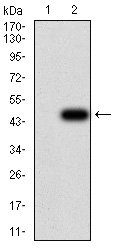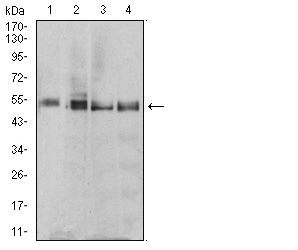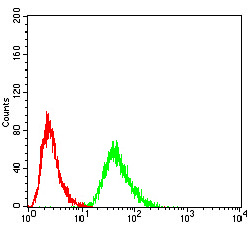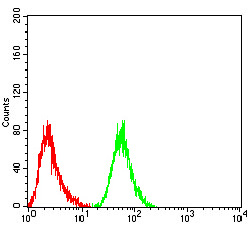Product Detail
Product NameRF1 Antibody
Host SpeciesMouse
ClonalityMonoclonal
PurificationProA affinity purified
ApplicationsWB, FC
Species ReactivityHu
Immunogen DescRecombinant protein
ConjugateUnconjugated
Other NamesCl1 protein antibody
D5S1995 antibody
ERF antibody
eRF1 antibody
ERF1_HUMAN antibody
ETF1 antibody
Eukaryotic peptide chain release factor subunit 1 antibody
Eukaryotic release factor 1 antibody
Eukaryotic translation termination factor 1 antibody
MGC111066 antibody
Polypeptide chain release factor 1 antibody
Protein Cl1 antibody
RF1 antibody
Sup45 (yeast omnipotent suppressor 45) homolog like 1 antibody
SUP45L1 antibody
TB3 1 antibody
TB3-1 antibody
Accession NoSwiss-Prot#:P62495
Uniprot
P62495
Gene ID
2107;
Calculated MW49 kDa
Formulation1*TBS (pH7.4), 1%BSA, 40%Glycerol. Preservative: 0.05% Sodium Azide.
StorageStore at -20˚C
Application Details
WB: 1:500-1:2,000
FC: 1:100-1:200
Western blot analysis of eRF1 on human eRF1 recombinant protein using anti-eRF1 antibody at 1/1,000 dilution.
Western blot analysis of eRF1 on HEK293 (1) and eRF1-hIgGFc transfected HEK293 (2) cell lysate using anti-eRF1 antibody at 1/1,000 dilution.
Western blot analysis of eRF1 on different cell lysate using anti-eRF1 antibody at 1/1,000 dilution. Positive control�� Lane1: MCF-7 Lane2: T47D Lane3: MOLT4 Lane4: Raji
Flow cytometric analysis of Hela cells with eRF1 antibody at 1/100 dilution (green) compared with an unlabelled control (cells without incubation with primary antibody; red).
Flow cytometric analysis of HepG2 cells with eRF1 antibody at 1/100 dilution (green) compared with an unlabelled control (cells without incubation with primary antibody; red).
Translation is carried out by the ribosome and several associated protein factors through three consecutive steps: initiation, elongation and termination. Termination of protein synthesis takes place when the ribosomal A site is occupied simultaneously by one of three stop codons and by a class 1 translation termination factor. In eukaryotes, this termination factor is the eukaryotic release factor 1 (eRF1), a protein that promotes hydrolysis of the last peptidyl-tRNA on the ribosome. eRF1 activity is stimulated by the association with the GTP-binding protein eRF3. eRF1 forms a quaternary complex with eRF3, GTP and the ribosome. This complex performs a dual role, where, in the "GTP state," it controls the positioning of eRF1 toward the stop codon and peptidyl-tRNA, and, in the "GDP state," it promotes the release of the eRFs from the ribosome. eRF1 contains a highly conserved Asn-Ile-Lys-Ser (NIKS) tetrapeptide, which is essential for the interaction of eRF1 with the ribosome. The gene encoding human eRF1 maps to chromosome 5q31.2.
If you have published an article using product 48424, please notify us so that we can cite your literature.







 Yes
Yes



